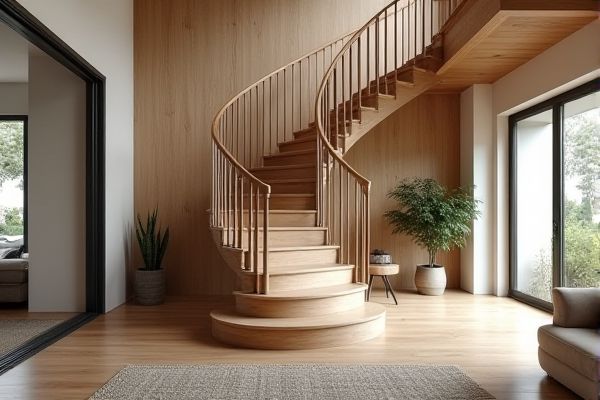
Double-helix stairs consist of two intertwined spirals allowing simultaneous upward and downward traffic without interference, making them ideal for high-traffic areas. Single-helix stairs feature a single spiral, offering a compact and elegant solution but may limit flow efficiency; explore the rest of the article to determine which stair design best suits Your space and needs.
Table of Comparison
| Feature | Double-Helix Stairs | Single-Helix Stairs |
|---|---|---|
| Structure | Two intertwined spirals sharing a central axis | Single spiral around a central column |
| Space Efficiency | More complex, potentially less compact | Generally more compact and space-saving |
| Usage | Allows simultaneous two-way traffic without crossing paths | Typically for one-way traffic or single-direction movement |
| Aesthetic Appeal | Highly architectural, visually striking | Classic and elegant design |
| Construction Complexity | High - requires precision engineering | Moderate - simpler build |
| Cost | Expensive due to complexity and materials | Lower cost, easier installation |
| Common Applications | Historic landmarks, luxury buildings | Residential homes, commercial spaces |
Understanding Double-Helix vs Single-Helix Stairs
Double-helix stairs feature two intertwining spirals allowing simultaneous ascent and descent without interference, optimizing foot traffic flow in confined spaces. Single-helix stairs consist of a single spiral winding around a central axis, providing a compact and visually striking design but limiting bidirectional movement. Understanding these structural differences is crucial for architects and engineers when designing efficient, space-saving staircases for public and private buildings.
Architectural History of Helical Staircases
Helical staircases have evolved since the Renaissance, with double-helix designs famously exemplified by Leonardo da Vinci's Chateau de Chambord, showcasing complex spatial innovation and structural ingenuity. Single-helix stairs, prevalent in medieval castles and earlier architecture, prioritize straightforward ascent with a singular spiral around a central axis. Both types reflect significant advancements in architectural engineering, with double-helix allowing simultaneous two-way traffic and enhancing functional flow in historic and modern designs.
Structural Differences: Double vs Single Helix Design
Double-helix stairs feature two intertwined spiral pathways that allow simultaneous upward and downward movement without interference, optimizing space and traffic flow. Single-helix stairs consist of a single spiral path, providing a simpler structure but limiting directional use and capacity. Your choice between these designs impacts structural complexity, material requirements, and functional efficiency in architectural projects.
Space Efficiency and Layout Considerations
Double-helix stairs optimize space by intertwining two staircases within a single cylindrical volume, effectively halving the footprint compared to two separate single-helix stairs. Single-helix stairs require more linear space and often limit layout flexibility due to their singular spiral path. Architects prioritize double-helix designs in confined areas like urban buildings or museums where efficient vertical circulation and compact layout are essential.
Aesthetic Appeal: Visual Impact Comparison
Double-helix stairs create a dramatic and intricate visual impact with their intertwined spirals, enhancing architectural sophistication and drawing immediate attention in spacious interiors. Single-helix stairs offer a sleek, elegant curve that emphasizes simplicity and fluidity, ideal for minimalist or modern designs seeking subtle yet striking aesthetics. The choice between them depends on the desired architectural emphasis: complexity and grandeur with double-helix or streamlined elegance with single-helix stairs.
Functional Advantages of Double-Helix Stairs
Double-helix stairs offer superior traffic flow by allowing two separate streams of movement simultaneously, reducing congestion in high-traffic areas such as public buildings and museums. Their intertwined design maximizes vertical space efficiency while maintaining structural stability, making them ideal for tight architectural footprints. Compared to single-helix stairs, double-helix stairs provide enhanced safety through dedicated up and down paths, minimizing collision risks and improving user experience.
Construction Challenges and Costs
Double-helix stairs present significant construction challenges due to their complex intertwining design, requiring precise engineering and fabrication to ensure structural integrity and safety. These stairs typically incur higher costs compared to single-helix stairs because of the increased material usage, specialized labor, and extended installation time. In contrast, single-helix stairs offer simpler construction processes and more cost-effective solutions, making them a preferred choice for projects with budget and time constraints.
Safety and Accessibility Factors
Double-helix stairs offer enhanced safety by reducing crowd congestion through two separate staircases, minimizing the risk of falls and collisions during high traffic situations. In contrast, single-helix stairs may limit accessibility due to narrower widths and less efficient traffic flow, increasing potential hazards for users with mobility impairments. Design considerations for double-helix stairs often include improved handrails and consistent tread patterns, which support safer navigation and better accessibility compliance compared to single-helix designs.
Iconic Examples of Helical Staircase Architecture
Double-helix stairs, exemplified by the Vatican Museums' Bramante Staircase, showcase an intricate design that allows two separate pathways spiraling around a central axis, optimizing spatial flow and visitor movement. Single-helix stairs, such as those found in the Loretto Chapel in New Mexico, feature a solitary spiral providing a graceful ascent within limited space, often emphasizing aesthetic elegance. Both types highlight architectural innovation, with double-helix structures symbolizing complexity and separation of traffic, while single-helix staircases emphasize simplicity and sculptural beauty.
Choosing the Right Helix Staircase for Your Project
Double-helix stairs offer a unique architectural statement with two intertwining spirals, maximizing space efficiency and allowing simultaneous traffic flow, ideal for large-scale projects. Single-helix stairs provide a more traditional spiral design, optimizing vertical movement in compact areas while maintaining aesthetic appeal. Your choice should balance design complexity, spatial constraints, and functional traffic needs to ensure the staircase complements the project's overall architecture and usability.
 homyna.com
homyna.com